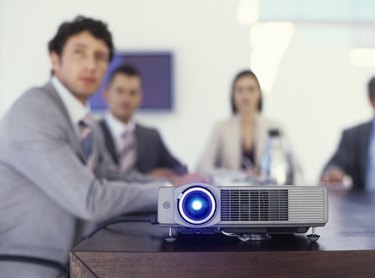
Video projectors can demand a significant investment from a business. Several factors affect the lifetime of a projector, and these should be taken into consideration to determine the total cost of ownership.
Factors Affecting Projector Lifetime
Video of the Day
The electronic components of a video projector can last for decades. But like most electronic devices, rough handling, overheating from poor ventilation or dust and unreliable power can significantly shorten the lifespan. Many video projectors use light bulbs as their illumination source, and the cost and availability of bulbs may effectively limit the lifetime of the projector.
Video of the Day
Handling
A portable video projector should always be transported in a padded carrying case and never left in a car or other location where it might be exposed to temperature extremes, such as a shelf in the sun. When set up, it should always be placed in a stable location away from the edges of tables. Cords should arranged to ensure they will not be caught or tripped over. If possible, the projector should never be moved once it is turned on. At the end of a presentation, the projector should always be allowed to fully cool before it is turned off and put away. A permanently mounted projector on a wall or ceiling is relatively safe from handling damage, but the location should be carefully chosen, taking into account vibration from overhead activity which can both damage the projector and cause an unpleasant shaking of the image.
Ventilation and Cleaning
Projector lamps operate at very high temperatures. Proper ventilation is important for both lamp life and the life of the electronics in the projector. Permanently mounted projectors must have space around them to ensure free flowing air is available. Papers and books should never be placed against portable projectors. Vents may also need periodic vacuuming to ensure they are not blocked with dust, and some projectors have filters that require regular cleaning.
Power and Usage Cycle
A surge protector can prevent damage to a projector's power supply circuitry. For permanent installations, an Uninterruptible Power Supply (UPS) can ensure proper cool-down in the event of a power failure. Frequent on and off cycling of the projector can shorten its life, but long periods of usage are also risky because they may lead to overheating in smaller projectors intended for residential use.
Lamp Life
Careful handling, good ventilation and stable power ensure long life to the electronics and the bulb. Using Economy mode, if available, lowers the brightness but increases the bulb life. However, the bulb will dim over time and eventually burn out no matter how carefully the projector is treated. The average bulb life is about 2000 hours, and in some cases replacing the projector may be more cost effective than replacing the bulb. A projector that has stopped functioning due to an expired but still working bulb can sometime be reset to continue using the existing bulb, but this is a short term solution that may damage the projector.
Lamp Free
Some newer projectors advertised as hybrid or lamp free use laser and/or LED technologies instead of a conventional bulb. These projectors are more rugged, use less power, and claim lifetimes of 10000 to 20000 hours. One of these projectors could be used for five hours a day every day for more than 10 years before reaching its life expectancy.